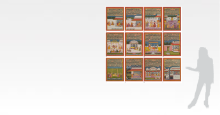
JAIPUR, CIRCA 1820
Inscribed in Nagari at the top (each)
Gouache on paper heightened with gold
Image: 9.5 x 5.5 in (24.7 x 14.4 cm) max size
Folio: 12.5 x 8.25 in (31.8 x 21.2 cm) max size
a) A dance performance in the month of Magh - Raga Nayaki
b) Rama presents a necklace to the performers in the month of Pausa - Raga Kafi
c) Raga Vasant the harbinger of the spirit of Spring
d) Rama and Sita play Holi to Raga Kafi in Fagun
e) Celebrating Holi in the month of Chaitra - Raga Kedar
f) Enjoying music in the month of Baisakh - Raga Jaijaivanti
g) Summer evening in the month of Jeth - Raga Sorath
h) Awaiting rain clouds in the month of Ashadh - Raga Sarang
i) Celebrating the festival of Teej in the month of Shravan - Raga Mor Malhar
j) Arrival of the month Bhadon - Raga Malhar
k) Rama and Sita seated in a pavilion - Raga Bhairava
l) Auspicious month of Kartik - Raga Lalit
(Set of twelve)
NON-EXPORTABLE REGISTERED ANTIQUITY
PROVENANCE
The Motichand Khajanchi Collection
The baramasa, or "songs of the twelve months," is a non-religious, classical text which expounds on the aesthetics of each month of the Hindu calendar in terms of the rhetoric of love. Poets employed metaphors extolling the attributes of deities, or of a maiden or nayika longing for the return of her lover to celebrate the particularities of nature as manifested each month. The 16th century poet Kesava Das, best known for his composition Rasikapriya, penned the most famous literary work on the baramasa, called the Kavipriya. Just as the Ragamala, Rasikapriya, Gita Govinda, Bhagavat Purana, Ramayana and Mahabharata were adapted from literary texts into folios by artists of the Rajasthani and Pahari schools, the baramasa was also a popular theme in miniature painting. The earliest baramasa paintings were made in Central India, and are now in the collection of the Patiala Museum and Central Museum in Lahore. The poetic themes of the baramasa, steeped in music, poetry, mythology and folklore, resonated with artists, and they interpreted the richness of the texts using styles and colour palettes distinct to their region. Their representation of specific flora and fauna, weather phenomena, myths and fables, rendered in distinct colours and sometimes accompanied by text corresponding to the season, determined the masa or month being referred to. Depictions of lovers, united and parting, with the corresponding sentiments of pining and longing were typical as studies of the mood of each season. Krishna and Radha as the nayak and nayika were artists' favourites.
The baramasa was especially popular among artists of the Jaipur and Bundi schools of Rajasthan. The Khajanchi Collection includes fine examples of both schools. The following baramasa folio is a complete set of twelve paintings from the 19th century Jaipur school of painting, characterised by strong colours and dynamic lines. Each month is represented with direct or indirect reference to the season and the musical raga associated with that particular time of year. The accompanying text by the poet Brahmadas is composed in couplets known as dohas. The verses are written in praise of Rama and Sita, set on the banks of the Sarayu river after the defeat of Ravana and the coronation of Rama. Unlike the more common depictions of Krishna and Radha as lovers, this folio uses the iconography of Rama and Sita in sringara rasa. It is extremely unusual to show Rama in romantic depiction, as he is considered the Maryada Purushottam, who is the epitome of valour and proper conduct.
Other similar works in:
this auction
|
entire site

Lot
36
of
81

CLASSICAL INDIAN ART | LIVE AUCTION, MUMBAI
9 MARCH 2017
Estimate
Rs 80,00,000 - 1,00,00,000
$121,215 - 151,520
RESERVE NOT MET

Size Size

Height of Figure: 6'